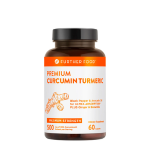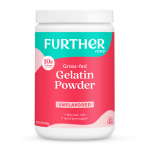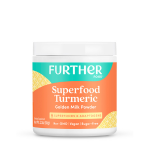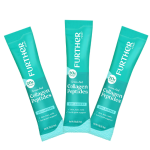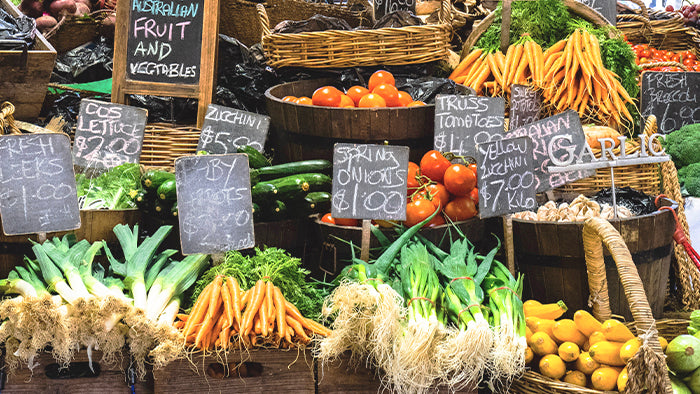The juicy tomatoes, cooling cucumbers and waxy beans of summer gardens may be waning, but equally delectable fall fruits and vegetables are just cropping up. Fall is the perfect time to reap the benefits of the summer sun, as squash blossoms give way to hearty kabochas, greens from chard, to spinach, to radicchio flourish, and root vegetables are unearthed. Here are Further Food Senior Editor Ashley Nickelsen's top 11 foods for fall that will warm and nourish you from the inside out.
 1. Carrots
1. Carrots – Carrots are well known for their beta-carotene, which is not only a great way to get vitamin A for eye health but is also a powerful antioxidant. Did you know that cooking carrots increase levels of beta-carotene? Instead of munching on raw sticks, throw them into warming fall soups like our
Roasted Carrot Soup.
 2. Cinnamon
2. Cinnamon – This ubiquitous fall spice increases circulation, keeping you warm as the mercury plummets. It’s also antimicrobial, helping keep you healthy throughout cold and flu season. Add some cinnamon to spice up your chocolate with this
spicy chocolate chili pepper bark!
 3. Apples
3. Apples – We all know that an apple a day keeps the doctor away. But did you know that fall is the best time to get apples at their freshest and most local? Out-of-season apples are shipped from New Zealand or have been stored for months on end, but fall is the perfect time to get apples fresh from farms across the country, from Washington to New York. Full of soluble fiber, vitamin C, and antioxidants like quercetin, it’s no wonder this tasty treat is the original superfood. Already got a bushel full? Try our
Cinnamon Apple Overnight Oats!
 4. Celery Root
4. Celery Root – The saying, “don’t judge a book by its cover,” definitely applies to celery root. This knobby, mangled-looking root may not be the prettiest fall vegetable, but what it lacks in looks it makes up for in flavor and nutrients. Rich in vitamin C, K and a host of Bs, as well as minerals such as phosphorus, iron, calcium and copper, this relative of celery (its bitter green stalks aren’t the same as those found in grocery stores), will enhance your well-being as well as your soups. Try these
salmon skewers with celery root mash for your next dinner.
 5. Jerusalem Artichokes
5. Jerusalem Artichokes – Also called sunchokes, Jerusalem Artichokes are the best prebiotic money can buy. This fiber-rich root is packed with inulin, a starch that the human body doesn’t have the enzymes to digest, but is a
superfood for gut bacteria. Healthy, well-fed gut flora helps boost immunity and mood. Increased fiber also adds bulk to stool, keeping things moving and preventing colon cancer.
 6. Parsnips
6. Parsnips – White foods tend to get a bad rap for nutritional quality, but don’t let the albino carrot appearance of parsnips fool you. This delicately sweet root is high in heart-healthy folate, potassium, manganese and vitamins C, K and E. Roast up cubes or strips for a sublime snack, or puree with potatoes or cauliflower for a nutritious and delicious side. For a crunchy snack, whip up these
baked carrot and parsnip chips!
 7. Radicchio –
7. Radicchio – The cool weather reduces radicchio’s bitter bite, leaving a more mellow flavor and a deeply satisfying crunch. Radicchio's unique wine-red hue puts its potent antioxidant power on display. Anthocyanins, zeaxanthins and lutein will keep free radicals at bay, while B-vitamins boost energy and metabolic health. Radicchio is also exceptionally high in vitamin K, with its 100g providing 212% of your RDA, keeping bones and blood functioning well. Radicchio is great in salads such as this
Radicchio Salad with Blood Oranges, Sausage and Chickpeas.
 8
8.
Kabocha Squash – Kabocha’s rich flesh lends a perfect, creamy texture to soups with a flavor that is both sweeter and richer than its cousins butternut squash and pumpkin. It is also lower in calories than butternut squash, while still packed with the same nutritional benefits from vitamins A and C, iron, folate and fiber. Did you know that you can use squash to make hummus? Check out this
Squash Hummus Dip.
 9. Swiss Chard –
9. Swiss Chard – Kale may have taken the 2010s by storm, but it’s not the only leafy green on the block. With 300 times the RDA for Vitamin K per serving, chard is sure to help keep your blood clotting and bone health in top form, and biotin keeps hair follicles healthy. Calcium, magnesium, potassium, iron, the antioxidants lutein and zeaxanthin, and fiber, are all included in chard’s extensive portfolio of benefits. Its most impressive compound might just be syringic acid, which helps to regulate blood sugar, making it a great option for diabetics. Throw some swiss chard along with any other leafy greens into a
pesto recipe that you can freeze and eat throughout the winter.
 10. Pumpkin Seeds
10. Pumpkin Seeds – After cooking up some of our killer pumpkin recipes (
pumpkin spice smoothie anyone? I also LOVE our grab-and-go
paleo pumpkin bread!) you'll have plenty of seeds leftover Pop them in the oven for a satisfying snack. Roasted pumpkin seeds are high in protein and heart-healthy omega-3s. In addition to essential minerals magnesium and zinc, they also contain tryptophan, which is a precursor to sleep hormone melatonin. Happy snoozin’!
 11. Figs
11. Figs – Fall is the perfect time to grab a ripe, juicy fig to satisfy your sweet tooth and load up on gut-friendly fiber. Just three figs contain 20% of the daily recommended fiber intake for women! They also contain prebiotics and are electrolyte balancing. While you’re at it, peel one apart and relish the beauty inside. Or, give this
cantaloupe and fig green smoothie a try!
Note: PLEASE consult with your doctor before making any changes to your diet or medications. The material on this site is provided for educational purposes only and is not to be used for medical advice, diagnosis or treatment.
BE HEALTHY EVERY DAY with Further Food Collagen Peptides! Collagen heals your body from the inside out. Learn more here!
Ready to cut sugar out from your life? Take the #SugarPledge and sign up for our FREE 7-Day Sugar Detox Challenge
 1. Carrots – Carrots are well known for their beta-carotene, which is not only a great way to get vitamin A for eye health but is also a powerful antioxidant. Did you know that cooking carrots increase levels of beta-carotene? Instead of munching on raw sticks, throw them into warming fall soups like our Roasted Carrot Soup.
1. Carrots – Carrots are well known for their beta-carotene, which is not only a great way to get vitamin A for eye health but is also a powerful antioxidant. Did you know that cooking carrots increase levels of beta-carotene? Instead of munching on raw sticks, throw them into warming fall soups like our Roasted Carrot Soup.
 2. Cinnamon – This ubiquitous fall spice increases circulation, keeping you warm as the mercury plummets. It’s also antimicrobial, helping keep you healthy throughout cold and flu season. Add some cinnamon to spice up your chocolate with this spicy chocolate chili pepper bark!
2. Cinnamon – This ubiquitous fall spice increases circulation, keeping you warm as the mercury plummets. It’s also antimicrobial, helping keep you healthy throughout cold and flu season. Add some cinnamon to spice up your chocolate with this spicy chocolate chili pepper bark!
 3. Apples – We all know that an apple a day keeps the doctor away. But did you know that fall is the best time to get apples at their freshest and most local? Out-of-season apples are shipped from New Zealand or have been stored for months on end, but fall is the perfect time to get apples fresh from farms across the country, from Washington to New York. Full of soluble fiber, vitamin C, and antioxidants like quercetin, it’s no wonder this tasty treat is the original superfood. Already got a bushel full? Try our Cinnamon Apple Overnight Oats!
3. Apples – We all know that an apple a day keeps the doctor away. But did you know that fall is the best time to get apples at their freshest and most local? Out-of-season apples are shipped from New Zealand or have been stored for months on end, but fall is the perfect time to get apples fresh from farms across the country, from Washington to New York. Full of soluble fiber, vitamin C, and antioxidants like quercetin, it’s no wonder this tasty treat is the original superfood. Already got a bushel full? Try our Cinnamon Apple Overnight Oats!
 4. Celery Root – The saying, “don’t judge a book by its cover,” definitely applies to celery root. This knobby, mangled-looking root may not be the prettiest fall vegetable, but what it lacks in looks it makes up for in flavor and nutrients. Rich in vitamin C, K and a host of Bs, as well as minerals such as phosphorus, iron, calcium and copper, this relative of celery (its bitter green stalks aren’t the same as those found in grocery stores), will enhance your well-being as well as your soups. Try these salmon skewers with celery root mash for your next dinner.
4. Celery Root – The saying, “don’t judge a book by its cover,” definitely applies to celery root. This knobby, mangled-looking root may not be the prettiest fall vegetable, but what it lacks in looks it makes up for in flavor and nutrients. Rich in vitamin C, K and a host of Bs, as well as minerals such as phosphorus, iron, calcium and copper, this relative of celery (its bitter green stalks aren’t the same as those found in grocery stores), will enhance your well-being as well as your soups. Try these salmon skewers with celery root mash for your next dinner.
 5. Jerusalem Artichokes – Also called sunchokes, Jerusalem Artichokes are the best prebiotic money can buy. This fiber-rich root is packed with inulin, a starch that the human body doesn’t have the enzymes to digest, but is a superfood for gut bacteria. Healthy, well-fed gut flora helps boost immunity and mood. Increased fiber also adds bulk to stool, keeping things moving and preventing colon cancer.
5. Jerusalem Artichokes – Also called sunchokes, Jerusalem Artichokes are the best prebiotic money can buy. This fiber-rich root is packed with inulin, a starch that the human body doesn’t have the enzymes to digest, but is a superfood for gut bacteria. Healthy, well-fed gut flora helps boost immunity and mood. Increased fiber also adds bulk to stool, keeping things moving and preventing colon cancer.
 6. Parsnips – White foods tend to get a bad rap for nutritional quality, but don’t let the albino carrot appearance of parsnips fool you. This delicately sweet root is high in heart-healthy folate, potassium, manganese and vitamins C, K and E. Roast up cubes or strips for a sublime snack, or puree with potatoes or cauliflower for a nutritious and delicious side. For a crunchy snack, whip up these baked carrot and parsnip chips!
6. Parsnips – White foods tend to get a bad rap for nutritional quality, but don’t let the albino carrot appearance of parsnips fool you. This delicately sweet root is high in heart-healthy folate, potassium, manganese and vitamins C, K and E. Roast up cubes or strips for a sublime snack, or puree with potatoes or cauliflower for a nutritious and delicious side. For a crunchy snack, whip up these baked carrot and parsnip chips!
 7. Radicchio – The cool weather reduces radicchio’s bitter bite, leaving a more mellow flavor and a deeply satisfying crunch. Radicchio's unique wine-red hue puts its potent antioxidant power on display. Anthocyanins, zeaxanthins and lutein will keep free radicals at bay, while B-vitamins boost energy and metabolic health. Radicchio is also exceptionally high in vitamin K, with its 100g providing 212% of your RDA, keeping bones and blood functioning well. Radicchio is great in salads such as this Radicchio Salad with Blood Oranges, Sausage and Chickpeas.
7. Radicchio – The cool weather reduces radicchio’s bitter bite, leaving a more mellow flavor and a deeply satisfying crunch. Radicchio's unique wine-red hue puts its potent antioxidant power on display. Anthocyanins, zeaxanthins and lutein will keep free radicals at bay, while B-vitamins boost energy and metabolic health. Radicchio is also exceptionally high in vitamin K, with its 100g providing 212% of your RDA, keeping bones and blood functioning well. Radicchio is great in salads such as this Radicchio Salad with Blood Oranges, Sausage and Chickpeas.
 8. Kabocha Squash – Kabocha’s rich flesh lends a perfect, creamy texture to soups with a flavor that is both sweeter and richer than its cousins butternut squash and pumpkin. It is also lower in calories than butternut squash, while still packed with the same nutritional benefits from vitamins A and C, iron, folate and fiber. Did you know that you can use squash to make hummus? Check out this Squash Hummus Dip.
8. Kabocha Squash – Kabocha’s rich flesh lends a perfect, creamy texture to soups with a flavor that is both sweeter and richer than its cousins butternut squash and pumpkin. It is also lower in calories than butternut squash, while still packed with the same nutritional benefits from vitamins A and C, iron, folate and fiber. Did you know that you can use squash to make hummus? Check out this Squash Hummus Dip.
 9. Swiss Chard – Kale may have taken the 2010s by storm, but it’s not the only leafy green on the block. With 300 times the RDA for Vitamin K per serving, chard is sure to help keep your blood clotting and bone health in top form, and biotin keeps hair follicles healthy. Calcium, magnesium, potassium, iron, the antioxidants lutein and zeaxanthin, and fiber, are all included in chard’s extensive portfolio of benefits. Its most impressive compound might just be syringic acid, which helps to regulate blood sugar, making it a great option for diabetics. Throw some swiss chard along with any other leafy greens into a pesto recipe that you can freeze and eat throughout the winter.
9. Swiss Chard – Kale may have taken the 2010s by storm, but it’s not the only leafy green on the block. With 300 times the RDA for Vitamin K per serving, chard is sure to help keep your blood clotting and bone health in top form, and biotin keeps hair follicles healthy. Calcium, magnesium, potassium, iron, the antioxidants lutein and zeaxanthin, and fiber, are all included in chard’s extensive portfolio of benefits. Its most impressive compound might just be syringic acid, which helps to regulate blood sugar, making it a great option for diabetics. Throw some swiss chard along with any other leafy greens into a pesto recipe that you can freeze and eat throughout the winter.
 10. Pumpkin Seeds – After cooking up some of our killer pumpkin recipes (pumpkin spice smoothie anyone? I also LOVE our grab-and-go paleo pumpkin bread!) you'll have plenty of seeds leftover Pop them in the oven for a satisfying snack. Roasted pumpkin seeds are high in protein and heart-healthy omega-3s. In addition to essential minerals magnesium and zinc, they also contain tryptophan, which is a precursor to sleep hormone melatonin. Happy snoozin’!
10. Pumpkin Seeds – After cooking up some of our killer pumpkin recipes (pumpkin spice smoothie anyone? I also LOVE our grab-and-go paleo pumpkin bread!) you'll have plenty of seeds leftover Pop them in the oven for a satisfying snack. Roasted pumpkin seeds are high in protein and heart-healthy omega-3s. In addition to essential minerals magnesium and zinc, they also contain tryptophan, which is a precursor to sleep hormone melatonin. Happy snoozin’!
 11. Figs – Fall is the perfect time to grab a ripe, juicy fig to satisfy your sweet tooth and load up on gut-friendly fiber. Just three figs contain 20% of the daily recommended fiber intake for women! They also contain prebiotics and are electrolyte balancing. While you’re at it, peel one apart and relish the beauty inside. Or, give this cantaloupe and fig green smoothie a try!
Note: PLEASE consult with your doctor before making any changes to your diet or medications. The material on this site is provided for educational purposes only and is not to be used for medical advice, diagnosis or treatment.
BE HEALTHY EVERY DAY with Further Food Collagen Peptides! Collagen heals your body from the inside out. Learn more here!
Ready to cut sugar out from your life? Take the #SugarPledge and sign up for our FREE 7-Day Sugar Detox Challenge
11. Figs – Fall is the perfect time to grab a ripe, juicy fig to satisfy your sweet tooth and load up on gut-friendly fiber. Just three figs contain 20% of the daily recommended fiber intake for women! They also contain prebiotics and are electrolyte balancing. While you’re at it, peel one apart and relish the beauty inside. Or, give this cantaloupe and fig green smoothie a try!
Note: PLEASE consult with your doctor before making any changes to your diet or medications. The material on this site is provided for educational purposes only and is not to be used for medical advice, diagnosis or treatment.
BE HEALTHY EVERY DAY with Further Food Collagen Peptides! Collagen heals your body from the inside out. Learn more here!
Ready to cut sugar out from your life? Take the #SugarPledge and sign up for our FREE 7-Day Sugar Detox Challenge








